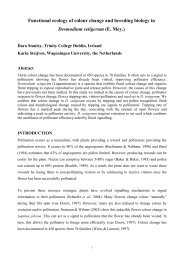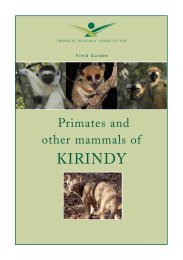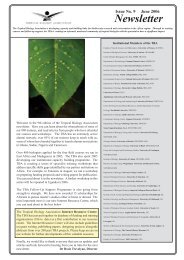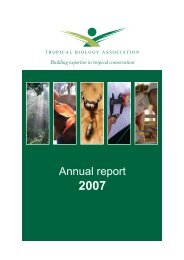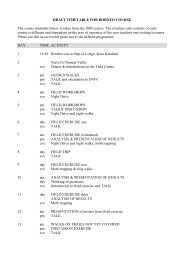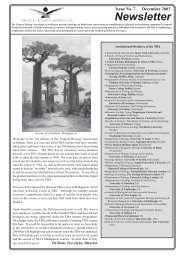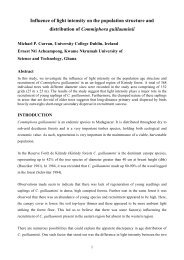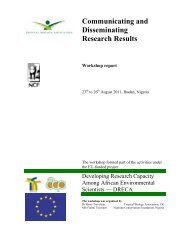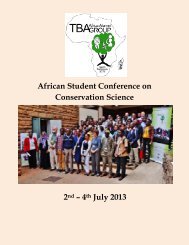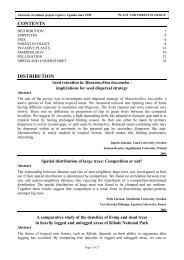Download TAAG Book of Abstracts - Tropical Biology Association
Download TAAG Book of Abstracts - Tropical Biology Association
Download TAAG Book of Abstracts - Tropical Biology Association
You also want an ePaper? Increase the reach of your titles
YUMPU automatically turns print PDFs into web optimized ePapers that Google loves.
Landscape Connectivity as a Strategy to solving Habitat<br />
Fragmentationacross Borders: A case study <strong>of</strong> Nigeria<br />
Fasona Michelle Iyabo<br />
Department <strong>of</strong> Zoology, University <strong>of</strong> Lagos, Akoka,<br />
Lagos, Nigeria<br />
Email for correspondence: babsmichelle@yahoo.com<br />
Abstract<br />
The fragmentation <strong>of</strong> natural habitats for animal wildlife<br />
population is a growing concern in nature conservation.<br />
The concept <strong>of</strong> landscape connectivity is considered to<br />
be useful in combating the challenge wildlife<br />
populations’ face in isolated fragmented habitats.<br />
Landscape connectivity has two main aspects; structural<br />
and functional connectivity. The main aim <strong>of</strong> landscape<br />
connectivity is to make connecting areas functional for<br />
wildlife dispersing to other habitats. In Africa landscape<br />
connectivity efforts have predominantly been directed<br />
towards trans-boundary conservation practices which<br />
focus on conservation <strong>of</strong> worthy lands across<br />
international borders. The use <strong>of</strong> remote sensing,<br />
Geographic Information System and spatial analysis<br />
models in selected transboundary conservation studies<br />
carried out in Africa are reviewed. Findings from the<br />
studies revealed habitat suitable areas that can serve as<br />
functional conduits for terrestrial mammals in<br />
fragmented landscape. The paper made a case for<br />
studies on landscape connectivity in Nigeria as a way <strong>of</strong><br />
conserving wildlife across borders.<br />
Keywords: Fragmentation, wildlife, Landscape<br />
connectivity and Transboundary conservation<br />
Understanding Relationship between Stand Structure<br />
and Carbon Stock in Nilo Nature Reserve, Tanzania<br />
1 *Mwainunu, E.J., 2 Munishi, P.K.T. and 3 Nzunda, E.F.<br />
1 Tanzania Forestry Research Institute, P. o. Box 30021,<br />
Kibaha, Costal Region.<br />
2 Department <strong>of</strong> Forest <strong>Biology</strong>, Sokoine University <strong>of</strong><br />
Agriculture, P. o. Box 3010, Morogoro.<br />
3 Department <strong>of</strong> Forest Mensuration and Management,<br />
Sokoine University <strong>of</strong> Agriculture, P.O. Box 3013,<br />
Morogoro<br />
Email for correspondence: emajaphet@yahoo.com<br />
Abstract<br />
Natural forests are characterized by high heterogeneity<br />
in their stand structure. Understanding the relationship<br />
between tree parameters and carbon stock is necessary<br />
for predicting carbon storage in forests. Few studies<br />
have estimated carbon storage in natural forests <strong>of</strong> the<br />
Eastern Arc Mountains in Tanzania. The study therefore<br />
assessed stand structure parameters and its relationship<br />
with carbon storage. Additionally, the study assessed<br />
the usefulness <strong>of</strong> the stand structure parameters for<br />
estimating carbon stock in the Nature Reserve. The<br />
forest was stratified into four elevation bands. Four<br />
marked permanent sample plots <strong>of</strong> size 0.4 ha with 80<br />
subplots <strong>of</strong> size 2010 m one in each elevation band<br />
was established. In each plot, the following information<br />
on diameter at breast height <strong>of</strong> trees with dbh ≥ 5 and<br />
wood cores at dbh were collected. The data was used to<br />
determine stand structure parameters (species richness,<br />
diversity, stem density, average diameter, basal area<br />
and volume) and biomass carbon stock. The coefficient<br />
<strong>of</strong> correlation R 2 was employed to depict the<br />
relationship <strong>of</strong> the stand parameters and carbon stock.<br />
A total <strong>of</strong> 77 species <strong>of</strong> trees and shrubs belonging to 29<br />
families were identified. Shannon index was 3.60<br />
indicating high plant species diversity. The stand<br />
density, average diameter, basal area and volume were<br />
299 ± 26 stems ha -1 , 26.07 ± 2.88 cm, 38.08 ± 3.61 m 2 ha -<br />
1 and 488.35 ± 56.32 m 3 ha -1, respectively. Above ground<br />
carbon stocks was 291 ± 32.81t ha -1 . Volume, base area<br />
and mean diameter were strongly positively related to<br />
carbon storage (p = 0.001). Relationship between<br />
volume and carbon stock has the highest R 2 (R 2 = 99%),<br />
hence can be used adequately for estimation <strong>of</strong> carbon<br />
stock in forests <strong>of</strong> the same type.<br />
Keywords:Natural forest, parameters, Biomass, carbon,<br />
Eastern Arc Mountains




